Research Article - Onkologia i Radioterapia ( 2022) Volume 16, Issue 10
Low dose ionizing radiation does not impact memory performances in adulthood
Ghofrane S. Cherkaoui1*, Sara Taleb1, Youness Kadil1 and Houda Filali1Ghofrane S. Cherkaoui, Department of Pharmacology and Clinical Toxicology, Faculty of Medicine and Pharmacy, Hassan II University of Casablanca, Morocco, Email: ghofranecherkaoui@gmail.com
Received: 10-Sep-2022, Manuscript No. OAR-22-74244; Accepted: 30-Sep-2022, Pre QC No. OAR-22-74244 (PQ); Editor assigned: 12-Sep-2022, Pre QC No. OAR-22-74244 (PQ); Reviewed: 27-Sep-2022, QC No. OAR-22-74244 (Q); Revised: 29-Sep-2022, Manuscript No. OAR-22-74244 (R); Published: 01-Oct-2022
Abstract
Introduction: we are all unavoidably exposed to Low dose ionizing radiation (LDIR). The present study was designed to highlight the effects of these radiation on the brain in adulthood by exploring the behavioural changes in rats exposed to a LDIR with a focus on memory and learning.
Methods: the study included 17 males “Wistar” rats with a group of young adults (36 months), exposed to a source of Cesium 137 with a cumulative dose estimated to 100 mGy of gamma-ray, and two control groups: young adults (3 months-6 months) and ageing group (>26 months). Then they were subjected to neurobehavioral tasks: Morris Water-Maze, Eight Arm-Maze and novel object recognition tests to evaluate the effect of exposure on learning and memory. Results: For all neurobehavioral tests, there were no significant differences in performances between exposed/ control groups. To our knowledge, this is the first study focusing only on neurobehavioral changes after exposure to low-dose electromagnetic ionizing radiations during adulthood (≤100 mSv). The current findings could serve as a good foundation for future studies using larger samples and including earlier assessments.
Keywords
Behaviour, low dose ionizing radiation, memory, radiation exposure
Introduction
Since the discovery of radioactivity, ionizing radiation applications have evolved all over the world. It has found its usefulness in peaceful applications in energy, industry and health among others. In the field of health, it became a key tool in the diagnosis and treatment of various diseases with more than 3.6 billion medical procedures using ionizing radiation annually worldwide [1]. These procedures cause radiation exposure to patients with an annual cumulative dose estimated at 3.0 milliSievert (mSv) per capita in developed countries (the Sievert being the equivalent biological effect of the deposit of 1 Joule of radiation energy per mass of a human body or Jkg-1) [2]. In addition to that, approximately 30 million medical workers are unavoidably exposed to these radiations, among them professionals in radiology and nuclear medicine, but also orthopedists, interventional cardiologists, dentists and veterinarians with regulations limiting the maximum dose to 20 mSv per year for persons employed in radiation work [1,3, 4]. other workforces such as aircrews, miners and nuclear industry workers are also professionally exposed to low-dose ionizing radiation daily [5].
Our understanding of the mechanisms responsible for the harmful effects of radiation exposure began in the early twentieth century by establishing a strong relationship between radio sensitivity and cell proliferation [6]. High doses of exposure are labelled as deterministic given their early and acute occurrence above a threshold (>1000mSv) whereas stochastic effects (carcinogenesis and hereditary effects) are chance events with a probability of increasing with a dose without a threshold level [4,7]. In the 1990s epidemiological studies started reporting effects other than cancer induction such as cardiovascular and neurological changes. However, little is known about the mechanisms involved in these relatively newly discovered effects, especially at Low Dose Ionizing Radiation (LDIR) below 100 mSv. United Nations Scientific Committee on the Effects of Atomic Radiation Effects of Ionizing Radiation: UNSCEAR 2006 Report to the General Assembly, with Scientific Annexes. New York, NY: United Nations; 2008.
The non-carcinogenic effects of these radiations on the brain are of particular importance. The scarce studies available did not provide sufficient evidence regarding their association with detrimental health effects [8]. Some studies using animal models reported slight changes in rodents ranging from adaptive response to neurobehavioral changes, altered vascularization and neurogenesis, especially after prenatal and neonatal exposure [2,9,10]. Therefore, available data are only fragmentary and do not allow a proper risk estimation of medical or occupational exposure to LDIR.
The present study was designed to highlight the effects of LDIR on the brain in adulthood by exploring the behavioural changes in murine subjects exposed to a LDIR with a focus on memory and learning.
Methods
Subjects
Subjects were 17 male “Wistar” rats weighing 250 g-385 g at the time of exposure divided into three groups. They were housed in a controlled environment (humidity and temperature) and a cycle of 12/12 hours of light/dark. All rats were bred in our laboratory facility and have not been included in any other previous study. Food and water were available continually unless experimental protocols required further modification. Research protocols were submitted and approved by the ethics committee before the beginning of any experiment. The general condition of each rat was assessed daily (Activity, voiding, defecation, consumption behaviour, rat fur and integuments). Body weight was measured using an electronic weighing scale. Weight monitoring was interrupted in the irradiation duration.
Radiation
Animals were group housed, kept in their home cages and separated into three groups:
1. Group 1. Adult rats (3 months-6 months) were irradiated at a dose rate of 0.5 mSv per hour for 200 hours continuously (3 days to 8 days approximately) in order to achieve an average of 100 mSv per individual.
2. Group 2. Adult rats (3 months-6 months) non-irradiated.
3. Group 3. Ageing rats (>26 months) non-irradiated.
Unexposed control rats (group 2 and group 3) were subjected to the same conditions (including housing location change) to minimize bias (especially due to anxiety).
The irradiation dose was obtained using an external source of 137 Cesium with a low dose rate (0,5 mSv/h) estimated by a Geiger-muller counter, the overall radiation dose received by the subjects was estimated using electronic personal dosimeters placed in each test cage. 137 Cesium is a man-made radioactive isotope, with a half-life of about 30 years (neglected decay) emitting beta- particles (Emax=514 KeV (94,6%) and producing the 137 m Barium) and gamma-ray emission (E=662 KeV (85%) emitted by the 137 m Barium).
Behavioural tests:
The experiment was double-blinded. The personnel included the principal investigator and two technicians. The technician responsible for the testing (loading and unloading each rat/placing each rat into the maze) did not know the exposure condition of each rat. The technician who assisted in the cleaning of the maze between each test trial was blind to the exposure condition of all rats. In addition, an independent individual was responsible for randomizing all of the rats into groups. A blinded statistical analysis was made after obtaining the complete data.
Experiments were performed at fixed times of the day in a dedicated experiment room adjacent to the housing room during the active cycle phase. All rats were handled carefully during dedicated handling sessions to limit handling stress during testing. Rats in each cage were marked on the tail in a gentle and indolent manner with an indelible marker. The tests were conducted blind during their active phase with background noise to camouflage the environmental noises. All measurements were recorded and hand scored by lab personnel.
Morris water maze test
In this test, the rats have to build up a representation or a map of their environment in order to locate precisely a platform immersed in an opaque water pool. The aim is to explore the behavioural bases of cognitive learning. We applied the different steps of the test based on the article published by Vorhees et al. [11]. We used for this test a circular shaped pool of 140 cm diameters and 50 cm depth, filled with water to a depth of 35 cm, at room temperature (22°+/- 1). We stuck multiple cues on the walls surrounding the pool rather than on nearby cues so that the experiment could assess their "allocentric" navigation. These cues were also used to draw imaginary lines to divide the pool into 4 quadrants of equal area (25% for each quadrant), with the platform in the southeast quadrant.
Training and Probe test:
The study started by assessing the speed at which the different rats swim, which reflects, first of all, their ability to swim (motor skills) as well as their motivation to escape from this situation, thus limiting the biases related to individual variabilities. The learning phase lasted 4 days: Two to three tests per day (3 hours minimum between tests). We placed each rat gently in the water, with its head facing the edge of the pool, taking care to change the starting position each time (quadrants: Northwest, then Northeast, then Southwest). The position of the platform and the spatial cues on the walls were not changed. during the entire study. In the training phase, rats were “helped” to reach the platform by guiding them to the right quadrant. The Probe test was carried out on the 5th day, the platform was immersed in opaque water (non-toxic white dye). The maximum lasting time was fixed to 60 seconds. Parameters evaluated were: time spent finding the platform and time spent in the platform quadrant [12].
Retention task:
Performed one week after the end of the Probe test in identical conditions (same spatial cues on the wall and same parameters evaluation), it allows the evaluation of consolidation memory [13-15].
Novel object recognition
This is a relatively rapid test that takes place over a period of three days [16]. During the first day, the animal is accustomed to the open field. It was placed in an open field for 10 minutes with no objects to explore, the goal being to limit stress bias by habituating the rat to exposed environments, knowing that if rats feel anxious, they will show novelty-avoidance in this test [11]. We also made sure to limit the risk of distraction by putting in background noise. The second day is the so-called "training" day or the rat is allowed to explore two identical objects placed in the open f ield. After 24 hours, one of the objects is replaced by a new one. T he test counts the number of attempts to explore each object and calculates the time spent with each object expressed as a percentage: the recognition index or: the time spent investigating the novel object relative to the total object investigation RI=TN/ (TN + TF) [17].
Radial arm maze
This test mimics the foraging behaviour of rats. For this purpose, we used the "win-shift condition" by putting the food in different arms of the previous trial. The aim of this study is to evaluate: reference memory and working memory. A radial arm maze is a device made of 8 wooden arms, each measuring 60 cm in length and 10 cm in width, communicating with a central platform of 25 cm in diameter. All the device was placed in height compared to the ground. At the end of each arm, we placed a small container to put in baits. The subjects of the experiment underwent a food restriction with a reduction of 15% of their usual rations, in order to stimulate their appetite and encourage the search for bait. We placed the subjects on the central platform from where they had to collect all the baits. At the beginning of the experiment, the subjects were accustomed to their environment by allowing them to freely explore this maze for 15 minutes per day and for 3 consecutive days, with the baits being placed in the 8-arm containers [11]. After this period, we continued to place the baits in 4 arms/8 randomly for 5 consecutive days. Each subject had one session per day which lasted either for 10min or until all baits were found. The session was interrupted when the rat remained motionless for more than 2 minutes. The performance of each subject was evaluated during these sessions by counting.
The number of errors, an error is whenever the subject revisits an arm it has already visited in the same session (if the rat revisits a baited arm after the bait was taken, then it scored as working memory errors and entries into never-baited arms are scored as reference (long term) or trial-independent errors).
The test also took into account the number of correct answers before making a mistake and the duration of each session (Figure 1).
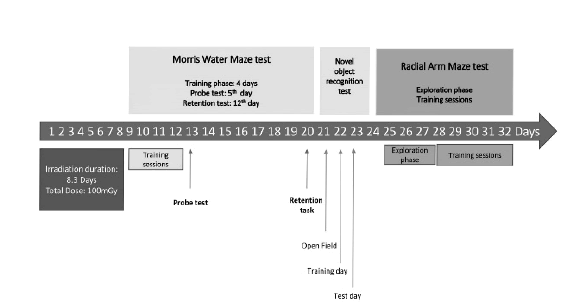
Figure 1: The study chronology: Radiation exposure and neurobehavioral tests
Statistical analysis
The results were compared using Graph Pad Prism statistics software. Data are expressed as mean values +/- Standard Error of the Mean (SEM). Statistical evaluations have been made first after being tested for normal distribution and equal variance. Depending on the normality of the test, we used either parametric (paired or unpaired Analysis of Variance (ANOVA)) or non-parametric tests (Kruskal-Wallis test). Differences were considered to be significant if p<0.05.
Results
Body weight evolution: The general condition assessment of each individual did not show a difference between the experimental groups (Activity, voiding, defecation, consumption behaviour, rat fur and integuments). Rat's body weight did not differ significantly from one group to another.
1. Effect of LDIR on escape latency and time spent in target quadrant by rats using Morris Water-Maze test
The acquisition data during training sessions (Figure 2) and probe test (Figure 3) showed that LDIR did not impact significantly learning. The results of two-factor ANOVA including repeated measures over training sessions revealed no significant difference between sessions and groups (Kruskal-Wallis test p=0.4441). Non parametic analysis during the probe test revealed no significant difference between groups (time spent finding the platform Kruskal-Wallis test p=0.9062/time spent in the platform quadrant p=0.9976). One-way ANOVA analysis during retention tasks (one week after the end of the probe test) also revealed no significant difference be tween gr oups: ti me sp ent fin ding the platform (p=0.6799) time spent in the platform quadrant Kruskal-Wallis test (p=0.5640) (figure 3).
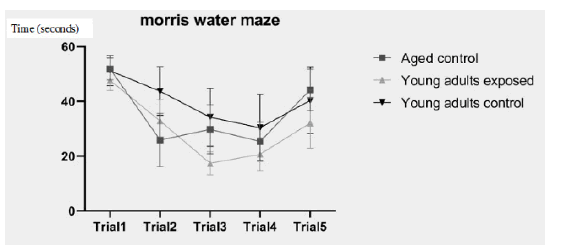
Figure 2: Rat escape latency during days 1-5 of training in the water maze test. Two-factor ANOVA including repeated measures over time (training sessions) didnâ??t reveal a statistical significance between groups (Kruskal-Wallis test p=0.4441).
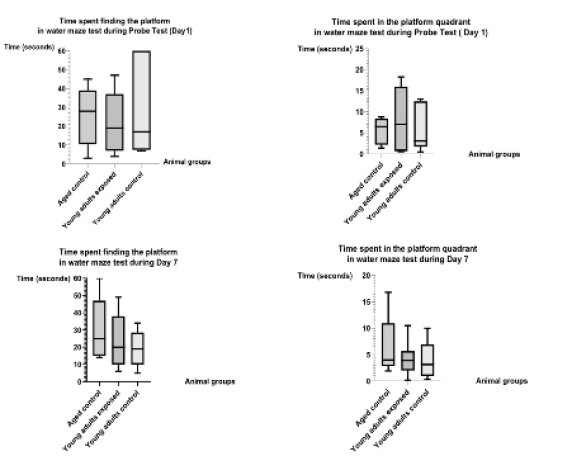
Figure 3: Adult rats Performances in Morris water maze test after exposure to 100mGy of gamma-ray using 137Cs source (Probe test or Day 1 and retention task on Day 7). The non-parametric analysis did not show a statistical significance between groups (exposed/ control)
2. Effect of LDIR on time spent by rats with the novel object using Novel Object Recognition test
The comparison between recognition indexes RI =TN/ (TN + TF) showed no difference statistically significant between groups (Figure 4) (Kruskal Wallis test p:0.5455).
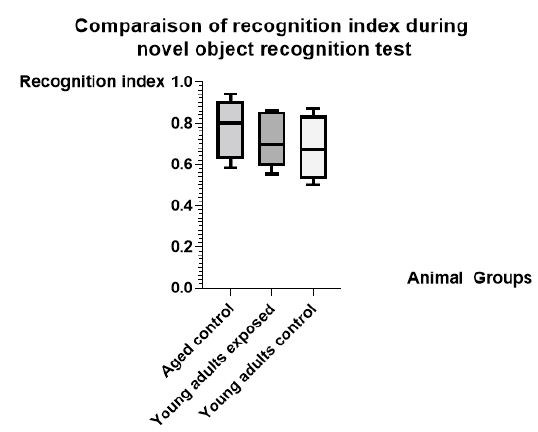
Figure 4: Comparison between recognition indexes during novel object recognition tests in exposed and control groups. The non-parametric analysis did not show a statistical significance between groups
3. Effect of LDIR on Radial arm maze test: (number of errors/ number of correct answers before making a mistake/ and the duration of the session)
Two-factor ANOVA including repeated measures over training sessions revealed no significant difference between sessions and groups when evaluating: Error rates (Kruskal-Wallis test p= 0.1100), Number of correct choices before error (Kruskal-Wallis test p=0.4144) and Time to Criterion (Kruskal-Wallis test p=0.3416) (Figure 5).
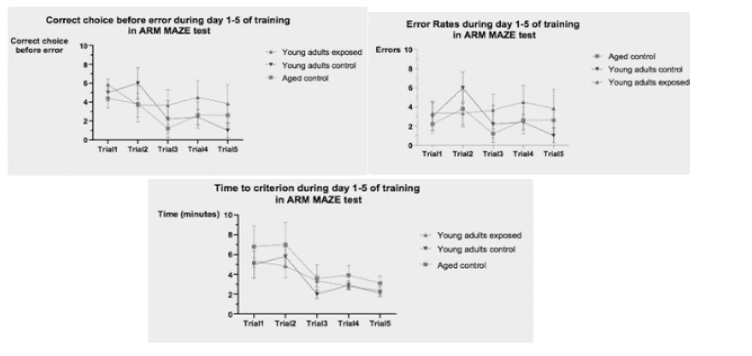
Figure 5: Rat performances in Radial Arm Maze (RAM) during days 1-5 of training (Two weeks after exposure of young adult rats group to 100mGy of gammaray using 137Cs source). Two-factor ANOVA including repeated measures over time (training sessions) didnâ??t reveal a statistical significance between groups
Non-parametric evaluation on day five did not reveal a statistical significance between groups (Error rates: Kruskal-Wallis test p= 0.4033/correct choices before error: Kruskal-Wallis test p=0.7827/time to criterion: Kruskal-Wallis test p=0.6356) (Figure 6).
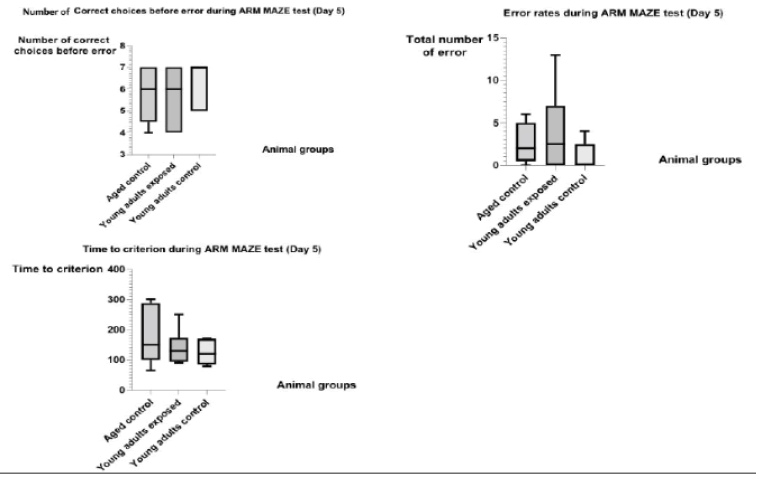
Figure 6: Rat's performances in Radial Arm-Maze test during the last session on the fifth day (After exposure of adult rats to 100mGy of gamma-ray using 137Cs source). The non-parametric analysis did not show a statistical significance between groups (exposed/ control)
Discussion
The goal of this study was to underline the effects of LDIR on the brain in adulthood. For this, we have evaluated behavioural changes in irradiated young adult rats in comparison to control groups (young adults and ageing rats). For all neurobehavioral tests used in this study, the overall ANOVAs showed no significant differences in performances between exposed/ control groups, which supports the hypothesis that exposure to gamma ray LDIR does not impact learning and memory.
Other than studies exploring the effects of exposure to particles of high energy and charge mimicking cosmic irradiation (Helium, Iron, Titanium and Silicon ions), to explore the risks of space travel, some authors focused on the effects of low dose electromagnetic ionizing radiations (X-Rays and gamma-Rays) given their importance to estimate risks and protect people against a potential hazard (especially as professionals (occupational exposures) and patients during their radiation diagnostic procedures) [18-20]. Most studies in the literature evaluating these types of radiations gave particular consideration to teratogenic effects and behavioural changes that occur after prenatal and neonatal exposure, they noted different deleterious effects such as cognitive defects, behavioural changes and pathologically, multiple hippocampal cellular anomalies [21, 22]. A lower number of authors explored the neurobehavioral effects of X-Rays and Gamma-Rays during adulthood. Other than documented carcinogenic effects, authors such as Lowe et al. suggested that LDIR can accelerate brain ageing processes. The transcriptome profiles analysis after exposing mice brain tissue to 100 mGy led to neural pathways down-regulations concordant with those found in the normal human ageing brain and in Alzheimer’s disease [23]. Other studies reported cellular changes after LDIR exposure with the induction of ageing lesions in different brain cells (neural stem cells, mature and immature neurons, endothelial cells and the different types of glial cells) [24].
To our knowledge, this is the first study focusing only on neurobehavioral changes after exposure to low-dose electromagnetic ionizing radiations. Koturbash et al. reported motoric and emotional disturbances in the ladder rung walking and the open field tasks during the first hours of exposure to a 100mGy of fractioned LDIR (4 hours). The author did not use memory and learning tests, however, the pathological evaluation showed a significant but transient loss of global genomic methylation in specific areas (frontal cortex, cerebellum and the hippocampus), these changes were no longer statistically significant 24 hours after the exposure in comparison to the control group [25]. Other studies showed that radiation exposure (500mGy) may be responsible for fatigue-like symptoms without any further behavioural evaluation [26].
In the current study, we used two control groups for the purpose of seeking behavioural differences between young adult rats (exposed and control) but also to compare eventual changes with the results found in the older age category.
T he neurobehavioral tests used are validated and standardized such as the Morris water maze test which assesses spatial memory and learning (Learning to find an immersed platform within an opaque pool of water) but also Working memory [27]. The advantage of this test over other learning and memory tests is this degree of motivation or "level playing field" compared to tests using food as motivation. The comparison between different parameters assessed during this test showed no difference statistically significant in comparison to control groups. The lack of significance during this test might be explained by the large variance amongst animals in our study which had not been prescreened before inclusion in the test. Most studies found in the literature tend to include only rats which have a given level of stable performance and expose them to a “treatment after several weeks of training”, however not pre-screening rats before the study has also the advantage of exploring learning acquisition at the very earliest stages and reflects more what may be extrapolated in the normal distribution of human population [28]. The second test used in this study was the novel object recognition task which uses the innate curiosity of the rat and their preference for new objects over those previously encountered, therefore it does not require positive or negative reinforcement (which is generally time-consuming and subject to bias). This test assesses Associative memory, Declarative memory and Working memory [27]. We have taken the time to place each rat in an open field with no objects to explore before commencing the test, the goal being to limit stress bias by habituating the rat to exposed environments, knowing that if rats feel anxious, they will show novelty-avoidance in this test [11]. The third and last test used in the current study was the RAM which evaluates the reference memory that allows us to remember the what (content: bait)/ and where (place: the arm), it also evaluates the working memory). This test mimics the foraging behaviour of rats by using the "win-shift condition" version by putting baits in different arms of the previous trial.
T he lack of statistical significance in these tests between groups can be related to the small samples included, but also to the timing we chose to perform these tests since the impact could have appeared early and transient as reported by Koturbash et al. [25]. A further study is still in progress in order to depict potential neuroanatomical, pathological or neurochemistry changes in brain tissue samples.
In conclusion, our findings provide additional evidence on the impact of electromagnetic LDIR exposure during adulthood by showing no detrimental impact on learning acquisitions and memory in the different neurobehavioral tasks. The current f indings could serve as a good foundation for future studies using larger samples and including earlier assessments.
Conflicts of Interest
The authors declare that they have no competing interests.
Contribution to authors
Houda Filali (Prof. M.D.), Younes Kadil (PhD), Sara Taleb (M.D.) and Ghofrane S. Cherkaoui (M.D.) contributed to the Conceptualization, Methodology, Implementation of the research and to analysis of the results. Ghofrane S. Cherkaoui and Houda Filali: writing of the manuscript.
Funding
None
Acknowledgements
The authors wish to thank Dr. Benider Houda of Ibn-Rochd University Hospital and Mr. EL BARQ Ilyas for their invaluable technical support.
References
- Mettler FA, Bhargavan M, Faulkner K, Gilley DB, Gray JE, et al. Radiologic and Nuclear Medicine Studies in the United States and Worldwide: Frequency, Radiation Dose, and Comparison with Other Radiation Sources—1950–2007. Radiology. Nov 2009;253:520‑531.
- Tang FR, Loke WK, Khoo BC. Low-dose or low-dose-rate ionizing radiation-induced bioeffects in animal models. J Radiat Res. 2017;58:165-182.
- Tang FR, Loke WK, Khoo BC. Low-dose or low-dose-rate ionizing radiation-induced bioeffects in animal models. J Radiat Res. 2017;58:165-182.
- Preface, Executive Summary and Glossary. Ann ICRP. avr 2007;37(2‑4):9‑34.
- Wakeford R. Radiation in the workplace—a review of studies of the risks of occupational exposure to ionising radiation. J Radiol Prot. 2009;29:A61.
- Mahesh M. The essential physics of medical imaging. Med Phys. 2013;40:077301.
- Ali YF, Cucinotta FA, Ning-Ang L, Zhou G. Cancer Risk of Low Dose Ionizing Radiation. Front Phys. 2020;8:234.
[CrossRef]
- Songrou FK, Tapiade EB, Ouimon M, Mobima T. Radiation protection knowledge of radiology technicians in Bangui and Bimbo (Central African Republic). Radiat Prot.2018;54:41-45.
- Mizumatsu S, Monje ML, Morhardt DR, Rola R, Palmer TD, et al. Extreme sensitivity of adult neurogenesis to low doses of X-irradiation. Cancer Res. 2003;63:4021-4027.
- Panagiotakos G, Alshamy G, Chan B, Abrams R, Greenberg E, et al. Long-term impact of radiation on the stem cell and oligodendrocyte precursors in the brain. PloS one. 2007;2:e588.
- Vorhees CV, Williams MT. Assessing spatial learning and memory in rodents. ILAR journal. 2014;55:310-332.
- Farso M, Ménard C, Colby-Milley J, Quirion R. The immune marker CD68 correlates with cognitive impairment in normally aged rats. Neurobiol Aging. 2013; 34:1971-1976.
- Jeljeli M, Strazielle C, Caston J, Lalonde R. Effects of centrolateral or medial thalamic lesions on motor coordination and spatial orientation in rats. Neurosci. Res.2000;38:155-164.
- Othman H, Ammari M, Sakly M, Abdelmelek H. Effects of repeated restraint stress and WiFi signal exposure on behavior and oxidative stress in rats. Metab. Brain Dis. 2017; 32:1459-1469.
- Morris RG, Inglis J, Ainge JA, Olverman HJ, Tulloch J, et al. Memory reconsolidation: sensitivity of spatial memory to inhibition of protein synthesis in dorsal hippocampus during encoding and retrieval. Neuron. 2006;50:479-489.
- Ennaceur A, Meliani K. A new one-trial test for neurobiological studies of memory in rats. III. Spatial vs. non-spatial working memory. Behav Brain Res.1992;51:83‑92.
[CrossRef]
- Antunes M, Biala G. The novel object recognition memory: neurobiology, test procedure, and its modifications. Cogn process. 2012;13:93-110.
- Krukowski K, Grue K, Becker M, Elizarraras E, Frias ES, et al. The impact of deep space radiation on cognitive performance: From biological sex to biomarkers to countermeasures. Sci. Adv. 2021;7:eabg6702.
- Lonart G, Parris B, Johnson AM, Miles S, Sanford LD, et al. Executive function in rats is impaired by low (20 cGy) doses of 1 GeV/u 56Fe particles. Radiat Res. 2012;178:289-294.
- Kiffer F, Alexander T, Anderson JE, Groves T, Wang J, et al. Late effects of 16o-particle radiation on female social and cognitive behavior and hippocampal physiology. Radiat Res. 2019;191:278-294.
- Eriksson P, Buratovic S, Fredriksson A, Stenerlöw B, Sundell-Bergman S. Neonatal exposure to whole body ionizing radiation induces adult neurobehavioural defects: critical period, dose—response effects and strain and sex comparison. Behav Brain Res.2016;304:11-19.
- Ganapathi R, Manda K. Later life changes in hippocampal neurogenesis and behavioral functions after low-dose prenatal irradiation at early organogenesis stage. Int J Radiat Oncol* Biol* Phys. 2017;98:63-74.
- Lowe XR, Bhattacharya S, Marchetti F, Wyrobek AJ. Early brain response to low-dose radiation exposure involves molecular networks and pathways associated with cognitive functions, advanced aging and Alzheimer's disease. Radiat Res. 2009;171:53-65.
- Wang QQ, Yin G, Huang JR, Xi SJ, Qian F, et al. Ionizing Radiation-Induced Brain Cell Aging and the Potential Underlying Molecular Mechanisms. Cells. 2021;10:3570.
- Koturbash I, Jadavji NM, Kutanzi K, Rodriguez-Juarez R, Kogosov D, et al. Fractionated low-dose exposure to ionizing radiation leads to DNA damage, epigenetic dysregulation, and behavioral impairment. Environ Epigenetics. 2016;2:dvw025.
- York JM, Blevins NA, Meling DD, Peterlin MB, Gridley DS, et al. The biobehavioral and neuroimmune impact of low-dose ionizing radiation. Brain Behav Immun. 2012;26:218-227.
- Wahl D, Coogan SC, Solon-Biet SM, De Cabo R, Haran JB, et al. Cognitive and behavioral evaluation of nutritional interventions in rodent models of brain aging and dementia. Clin Interv Aging. 2017;12:1419.
- Cobb BL, Jauchem JR, Adair ER. Radial arm maze performance of rats following repeated low level microwave radiation exposure. Bioelectromagnetics. 2004; 25:49-57.



